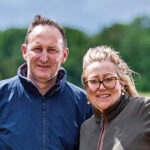Farmer Focus: Sucklers gain condition after arid summer
 Dan and Catherine Mercer © Richard Stanton
Dan and Catherine Mercer © Richard Stanton All things considered, it has been a good autumn here so far.
With the crops in the ground and the drill tucked up in the barn until next spring, we can focus on getting on with the cattle work.
See also: How the regen farming route works for a downland dairy
During the last week of October, we were busy weaning off the suckler calves and bringing them back home and into the sheds for the winter.
The current favourable weather means we are still able to graze the last of the grass where we can, with nearly all the dairy-beef and home-bred cattle still outside behind electric fences.
The suckler cows have had a particularly hard time over the summer on the chalk grassland.
The desert-like conditions here really did have an adverse impact on them.
Thankfully, in the past few weeks, they have started to gain back some much-needed condition ready for outwintering on Salisbury Plain and calving in March.
Unfortunately, the arid conditions meant we didn’t get a second cut of grass silage this year, and the rain came too late in the season for any significant growth.
We decided that what grass was there would be better utilised for grazing rather than us spending time and money cutting it, only to feed it back to the cows again a few weeks later.
Winter feed stocks are going to be significantly lower than last year too; regrettably, we didn’t manage to cut any hay at home this year either.
Next, we will be looking at herd performance when we pregnancy test our sucklers. We will then closely analyse the results and implement any necessary changes.
Previous conception rates have always been around or above the 97.5% mark, and it would be good to see that again.
However, the unpredictable weather conditions this year may well have had an impact on the results.
Changing our herd genetics from continental breeds to Aberdeen Angus and Beef Shorthorn has proved worthwhile, and they are much more suited to our business and system.
Nevertheless, even with implementing as many changes as possible to keep farming both sustainably and financially, we can’t guarantee the weather or what the government has in store for any of us.
The next few weeks are going to interesting, to say the least.

